Pomsky
Canis lupus
The howls and barks of a Pomsky can sound like singing
Advertisement
Pomsky Scientific Classification
- Kingdom
- Animalia
- Phylum
- Chordata
- Class
- Mammalia
- Order
- Carnivora
- Family
- Canidae
- Genus
- Canis
- Scientific Name
- Canis lupus
Read our Complete Guide to Classification of Animals.
Pomsky Conservation Status
Pomsky Facts
- Diet
- Omnivore
Pomsky as a Pet:
- General Health
- Energy Level
- Shedability
- Trainability
- Intelligence
- Tendency to Chew
- Size
- Family and kid friendliness
- Yappiness / Barking
- High
- Separation Anxiety
- High
- Preferred Temperature
- Cold climate
- Exercise Needs
- High
- Friendly With Other Dogs
- Group
- Pure bred cost to own
- $1500
- Dog group
- Non-sporting
- Male weight
- 20-30 lbs
- Female weight
- 20-30 lbs
This post may contain affiliate links to our partners like Chewy, Amazon, and others. Purchasing through these helps us further the A-Z Animals mission to educate about the world's species.
View all of the Pomsky images!
The howling of a Pomsky can sound like singing.
Breed a Pomeranian with a Siberian Husky and you get a Pomsky. Though Pomskies are a mix between these two purebreds, this hybrid normally has the appearance of a mini husky. The history of this dog only goes back ten years or so when a photo of a Pomsky puppy appeared online sparking the popularity of this dog. It belongs to the hybrid group.
See all of our expert product reviews.
Pomskies are intelligent, confident, and loyal. These are affectionate dogs that love to stay in the company of their owner. They are vocal canines that love to bark and let out long howls. A Pomsky is an excellent choice for a family looking for an active dog with a friendly temperament.
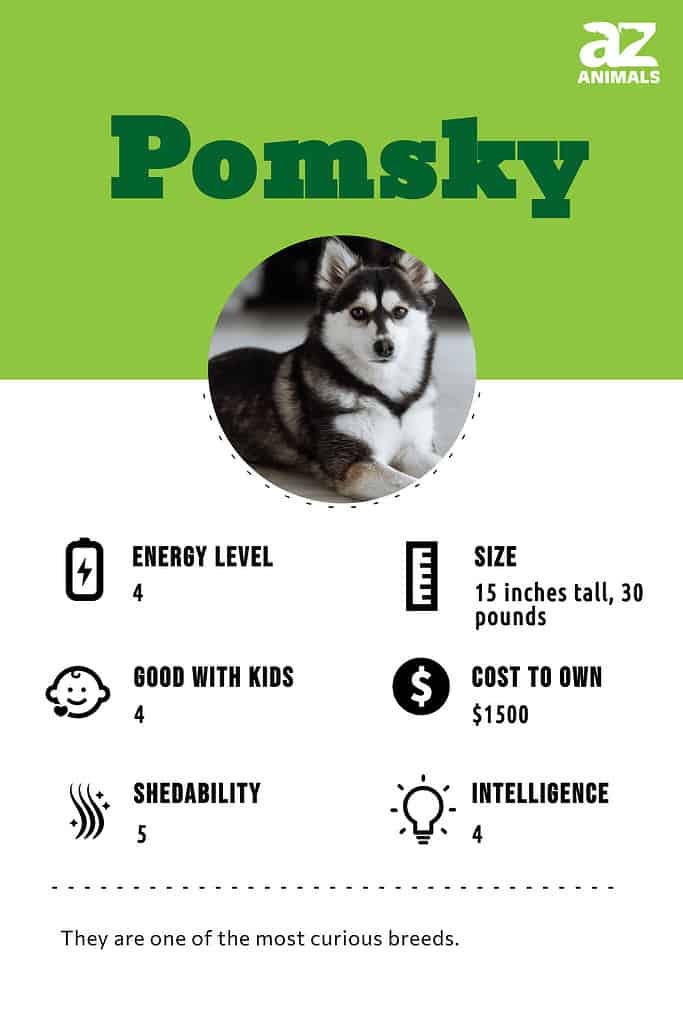
The Two Different Types Of Pomskies And Pomsky Mixes
There are two different types of Pomskies separated by size:
- Standard
- Teacup or mini
History Of The Breed
The pomsky is a mixed breed and although the history of this dog only goes back about ten years, its parent breeds, the Siberian husky and the pomeranian, do have a deeper history. The Siberian husky is believed to date back over 4000 years ago, originating in Siberia, Russia where they were developed by the Chukchi people of the Chukchi Peninsula. The pomeranian is believed to have descended from the spitz type dog from the Arctic region of Iceland. These spitz dogs were eventually transported to the Baltic region of Europe, what is now present day Germany and Poland but what was once known as Pomerania, which is where the breed got their name.
3 Pros And Cons Of Owning A Pomsky
| Pros! | Cons! |
|---|---|
| A loyal dog These dogs are very loyal to their owners. Some owners think of their Pomsky as a second shadow! | Extremely active This dog has a high level of energy and needs at least an hour of exercise each day. |
| A diligent watchdog These dogs are experts at alerting their owner of someone at the door or on the property. | A high level of shedding Pomskies shed a lot of hair on floors and furniture. |
| Good with kids Socialized Pomskies are good with the children and the adults in a family. | Expensive to buy The initial price for a Pomsky puppy can be high. It’s not uncommon to see breeders charging at least $1000 for their Pomsky puppies. |
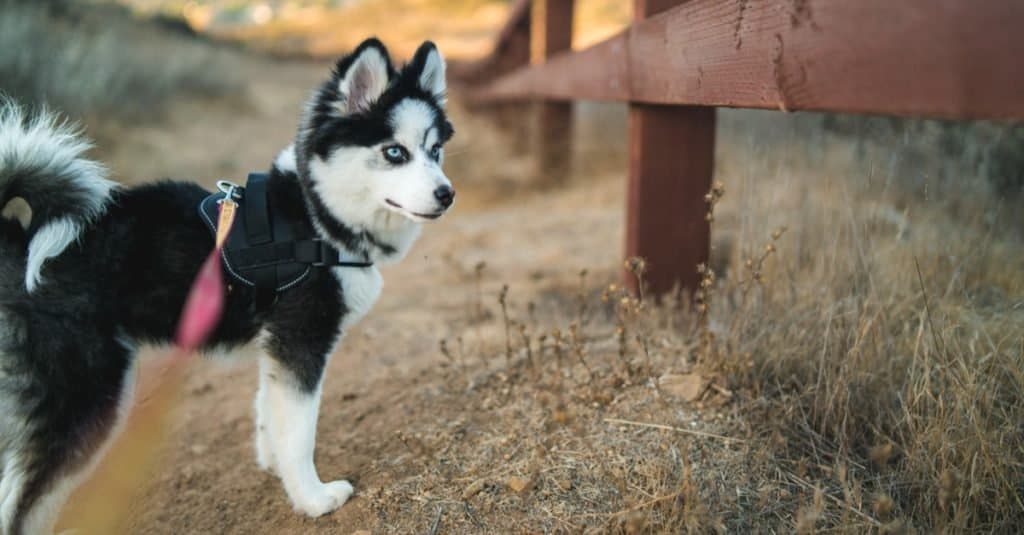
©Jonathan Byrne/Shutterstock.com
Size And Weight
Male and female standard Pomskies weigh up to 30 pounds as adult dogs. Both male and female dogs can grow to 15 inches in height full grown. Pomsky puppies weigh about 6 pounds at 7 weeks old. These dogs are considered full-grown between 12 and 18 months old.
Health and Entertainment for your Pomsky
See all of our expert product reviews.
| Height (Male) | 15 inches tall |
| Height (Female) | 15 inches tall |
| Weight (Male) | 30 pounds, full-grown |
| Weight (Female) | 30 pounds, full-grown |
Common Health Issues
These dogs have a few common health issues. One of those is patellar luxation. Patellar luxation is essentially a dislocated knee. Limping and hopping are signs of patellar luxation. Supplements can be effective in treating this condition, but surgery may be needed for more severe cases. A second common health issue is progressive retinal atrophy. This eye disease is not painful, but it can lead to blindness. A dog that has trouble seeing at night may be suffering from this condition.
Hair loss is another common health issue. This is a genetic condition that can be inherited from the Pomeranian side of the family. A change in diet and the addition of Omega-3 fish oil can help to lessen hair loss. The most common health issues of Pomskies are:
- Patellar luxation
- Progressive retinal atrophy
- Hair loss
Temperament And Behavior
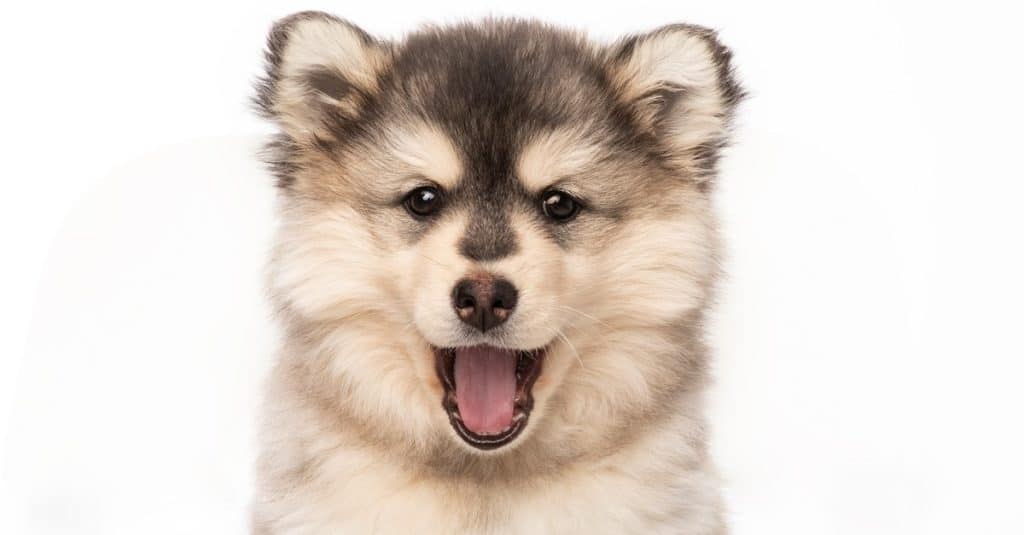
Pomskys love to express themselves through barking and howling.
©Crystal T/Shutterstock.com
These dogs have a friendly, lively temperament. These cute bundles of fur love to express themselves through barking and howling. This hybrid dog is known for its energetic behavior. This is not surprising because both its Pomeranian and Siberian Husky parents are high-energy dogs.
Loyalty is one of the most notable traits of this hybrid dog. This is part of what makes it such a great watchdog. Whether family members are hanging out in the living room or playing in the backyard, this social dog wants to be included in the fun!
How To Take Care Of A Pomsky
In order to provide the best level of care, an owner must learn about the diet, exercise, grooming, and healthcare needs of their Pomsky puppy or adult dog. Not surprisingly, the needs of this pet change as it grows from a puppy into an adult dog. Look at some of the specifics of its care.
The Best Dog Food For Pomskies
As a Pomsky grows from a puppy into an adult dog, it needs different types of nutrients. Furthermore, planning this dog’s diet with care can help to fend off some of its common health issues. Check out some factors to keep in mind when selecting dog food.
Puppy food: Lean protein is a must-have in the diet of puppies. Specifically, protein supports healthy muscles, bones, and cartilage. This ingredient can be effective in preventing patellar luxation. Omega 3 and 6 fatty acids contribute to the health of a puppy’s skin and coat. Also, these fatty acids are helpful in preventing the common health issue of hair loss in this hybrid. In addition, fat in a puppy’s diet supplies it with energy which is especially important for high-energy dogs like Pomskies! Calcium supports the development of strong bones, claws, and teeth. Fiber helps puppies to digest their food properly.
Adult dog food: Protein is required in an adult dog’s diet to maintain the health of its muscles, joints, and cartilage. Adult Pomskies still need fat in their diet, but less fat than puppies. Giving an adult Pomsky a limited amount of fat provides it with the energy it needs while preventing obesity in this fairly small dog. Vitamin C strengthens a dog’s immune system helping it to fight off allergies and other ailments. Additionally, Vitamin A supports eye health which is crucial for a dog prone to progressive retinal atrophy. Fiber helps with an adult dog’s digestion as well.
By our estimation at A-Z Animals, the best dog food for Pomskies is Purina Pro Plan Small Breed Shredded Formula Lamb & Rice Adult Dry Dog Food.
Most importantly, we like this lamb and poultry recipe for preventing joint problems like patellar luxation because there’s calcium, phosphorus, and natural sources of glucosamine. Also, with vitamins A and E, and biotin, you can trust your Pomsky’s health will be in order, including the fur and eyes.
Try out Purina Pro Plan Small Breed dog food, available on Chewy or Amazon.
- Nutrient-dense bite-sized kibble and small tender, shredded pieces for a taste and texture dogs love.
- High protein formula with real chicken as the first ingredient.
- Fortified with guaranteed live probiotics to support digestive and immune health.
- Used to be known as SAVOR Shredded Blend Chicken and Rice Formula.
- Formulated high in protein to meet the needs of highly active small dogs.
Maintenance And Grooming

Pomsky dogs shed on a regular basis and they do shed a large amount.
©Max Maximov/Shutterstock.com
How much does a Pomsky shed? These dogs shed a large amount of hair. They shed on a regular basis as well as seasonally. This makes a daily grooming routine all the more important.
Grooming the double coat of this dog can be done with an undercoat rake and a slicker brush. An undercoat rake is just what it sounds like. It removes tangles and loose or dead hair from the layer of coat nearest the dog’s skin. Alternatively, the slicker brush removes tangles from the upper layer of the dog’s coat.
Since hair loss is a common health issue of this hybrid, brushing it every day allows an owner to note any issues. A veterinarian can recommend the proper treatment for hair loss.
Training
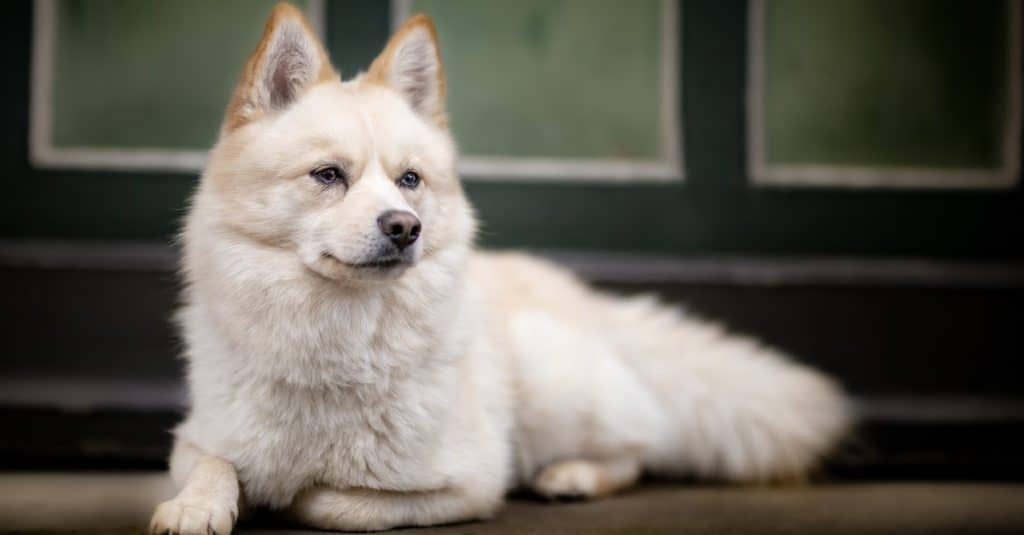
Pomskies are highly intelligent and can sometimes be stubborn.
©Pawtraits/Shutterstock.com
One of these dogs’ best qualities is their intelligence. But this high intelligence can sometimes come with a stubborn streak that interferes with obedience training. So, it’s a good idea to perform obedience training in an area with very few distractions. Also, treats and verbal praise are effective tools when training this smart hybrid dog.
An Akita is another intelligent yet stubborn dog that can be challenging to train.
Exercise
These are high-energy dogs that need at least one hour of exercise each day. This is important because if these dogs aren’t given the right amount of activity, they can start to chew items in a home.
Walking a trail in the woods or a park, playing fetch in the backyard or going to the dog park are all fun ways to exercise this pooch.
This hybrid dog is not a suitable pet for someone who lives in an apartment. Even though the dog is fairly small in size, it needs lots of space to move around. A home with a backyard is a better fit for a standard Pomsky. A teacup Pomsky is a suitable choice for an apartment dweller.
Puppies
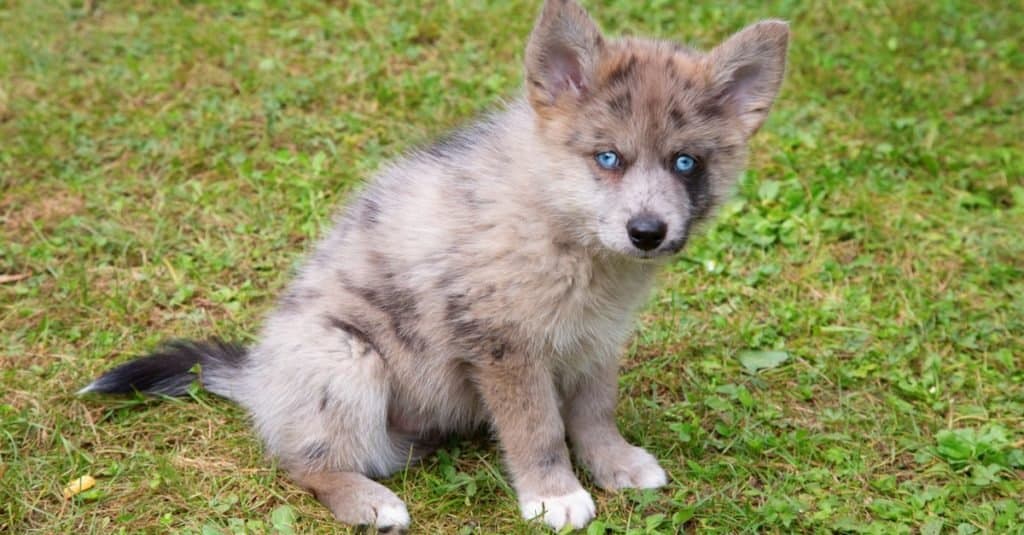
©Fedor Selivanov/Shutterstock.com
Standard Pomsky puppies look like little balls of fur. Pomsky teacup puppies are even smaller. So, it’s important for family members to be aware of the quick movements of these puppies so they won’t accidentally be stepped on and injured.
Pomsky And Children
The young children in a family are likely to want to pick up and handle the new puppy in the household. It’s a smart idea for parents to teach kids how to handle their pet in a safe, respectful way. This is an important step in making sure a Pomsky becomes more socialized as it grows.
Dogs Similar To The Pomsky
Other similar dog breeds to these dogs include the Samoyed, the Keeshond and the Akita.
- Samoyed – Samoyeds have a double coat of thick hair like Pomskies and have a stubborn temperament. However, Samoyeds are larger in size than Pomskies.
- Keeshond – Keeshonds, and Pomskies are both energetic dogs. Both dogs can have a coat featuring a mixture of black, cream and gray fur. A difference between them is Keeshonds are larger in size.
- Akita – Both Akitas and Pomskies are intelligent dogs with a loyal temperament. Akitas are much larger than Pomskies in size (weight and height).
Popular Names For The Pomsky
Some popular names for these dogs include:
- Gus
- Pip
- Oscar
- Teenie
- Charlie
- Bonnie
- Ezra
- Twilight
- Sophie
- Peanut
Pomsky FAQs (Frequently Asked Questions)
What is a Pomsky?
A Pomsky is a hybrid dog. It’s the result of breeding a Pomeranian and a Siberian Husky. There’s the standard size Pomsky as well as the much smaller teacup or mini Pomsky. These dogs are intelligent, loyal, and playful.
How much does a Pomsky cost to own?
The initial price of a Pomsky puppy is around $1000.
There are some rescue organizations operating today that allow people to adopt Pomskies for a reasonable fee.
The vet costs for this hybrid dog range from $500 to $800 each year.
The food costs for a Pomsky range from $200 to $300 per month. Buying dog food in bulk can help to lower food costs.
Are Pomskies good with kids?
Socialized Pomskies are good with kids.
How long do Pomskies live?
Pomskies live from 13 to 15 years.
How much does a Pomsky cost?
Most breeders charge a price of around $1000 for a Pomsky puppy. People looking for an alternative to buying from a breeder may want to contact a local Pomsky rescue organization. These rescue organizations charge an adoption fee for their puppies and adult dogs. That fee is much less than the price most breeders would charge for a puppy.
Why are Pomskies so expensive?
Pomsky puppies sold by breeders are expensive because they are in high demand. This is true for both standard and teacup varieties. Plus, their Pomeranian and Siberian Husky parents have a lot of good qualities. So, it stands to reason that a hybrid puppy would also possess many of those qualities.
How big is a full grown Pomsky?
A full-grown Pomsky can weigh anywhere from 20 to 30 pounds. They can grow to a height ranging from 10 to 15 inches.
Teacup, or mini, Pomskies weigh between 3 and 8 pounds full grown and reach a height of no more than 10 inches.
Are Pomskies good family dogs?
Yes! These hybrid dogs are loyal, playful, and love to spend time with their families.
What's the difference between a Pomsky and a Klee Kai?
The Pomsky grows larger than the average Klee Kai, and Klee Kais are purebred dogs recognized by the AKC. Pomskys are a hybrid breed.
Thank you for reading! Have some feedback for us? Contact the AZ Animals editorial team.
Sources
- Brookside Pomskies, Available here: https://www.brooksidepomskies.com/blog/how-to-help-your-pomsky-with-separation-anxiety
- Wikipedia, Available here: https://en.wikipedia.org/wiki/Pomeranian_dog
- Puppy Toob, Available here: https://puppytoob.com/teacup-pomsky/


















